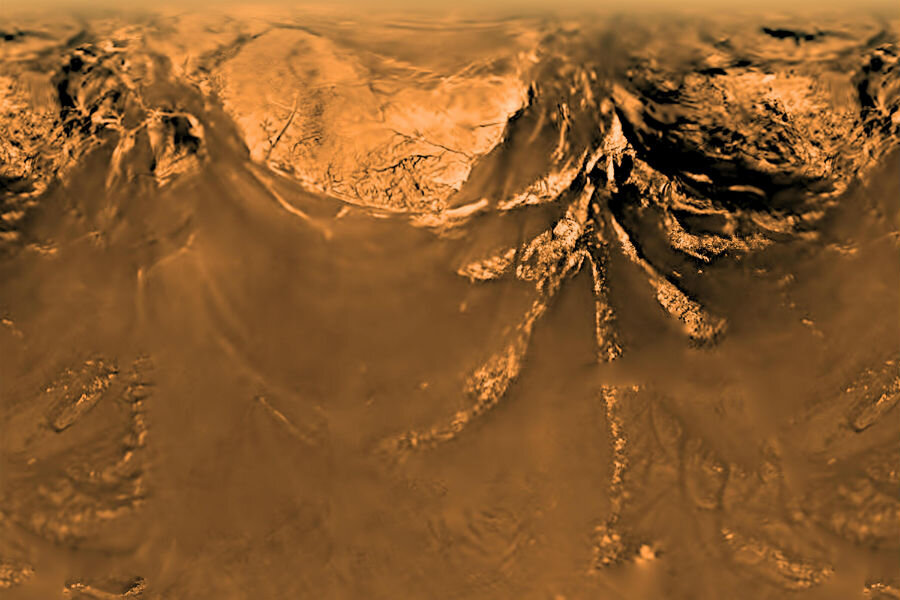Could Saturn's moon Titan host life, even without water?
Loading...
When Kurt Vonnegut’s protagonist, Malachi Constant, travelled to the surface of Saturn’s moon Titan, he found the source of his destiny. New research focused on Titan, using data from the Cassini spacecraft and the Huygens probe, has added more credence to theories that Titan may also be another kind of source – a moon with potential to give rise to life.
A study released this week by researchers at Cornell University suggests that prebiotic chemical conditions may exist on Titan's surface due to the potential presence of polyimine chains. These molecules are capable both of staying flexible in extreme cold conditions and absorbing the small amounts of the sun’s energy that make it through Titan's murky atmosphere, thus combatting two major barriers that would inhibit prebiotic pathways to life.
The scientists' focus, however, was not on the origins of life. Rather, they set out to answer to an atmospheric puzzle: Titan's atmosphere contains hydrogen cyanide, believed to be a building block of life on Earth, but that molecule is absent from the satellite's surface. The hydrogen cyanide must react and transform – but what does it become on the surface?
In polyimine, lead researcher Martin Rahm found both a viable answer to the puzzle and a dynamic molecule that, if it does exist on Titan, could be a potential building block of life.
The research focused on proving, through rigorous, controlled modeling and testing that polyimine, which has already been identified in other studies as a polymer that readily forms from hydrogen cyanide, could exist on Titan's surface. But the researchers also acknowledge the origins-of-life implications of the research.
“The question of the origin of life on the Earth and the ubiquity of life in the cosmos are really very important questions,” says Cornell planetary scientist Jonathan Lunine, an author of the study who has dedicated much of his professional life to studying Titan. “Understanding the extent that other worlds and our solar system have life – those would be very profound discoveries – so the exploration of these other worlds are crucially important, and knowing what we might want to be looking for, that is the point of this kind of research.”
Titan has been a particular point of interest for origin-of-life studies because of its atmospheric and geological similarities to Earth. Like Earth, Titan has lakes, rivers and seas.
Yet instead of water, they are filled with liquid methane and ethane. And unlike what Dr. Rahm calls Earth's "warm and pleasant environment," Titan’s temperatures are a frigid 290 degrees Fahrenheit below zero. There is another key difference: Titan has no liquid water, which has been considered the holy grail in the search for conditions that would sustain extraterrestrial life.
Robert Minard, a chemist who has worked on how hydrogen cyanide polymers could have led to the formation of nucleic acids but was not involved in this study, points to the absence of water as one of the key detriments to life pathways continuing on Titan, despite building blocks that could exist.
He emphasizes the analogous presence of nitrogen in Titan’s atmosphere and that of the early Earth, but says, “if you want to have life, you also need water, and that’s where Titan fails.”
Speaking generally from his own research and familiarity with Titan, Dr. Minard, a senior lecturer emeritus at Pennsylvania State University, says it is “possible that the chemistry going on there could lead to self-replicating life forms, but it's difficult for me to see how that could happen because oxygen is such an important part of bio-molecules.”
Rahm acknowledges this problem as well, but he says this could be part of our Earth-bias, an assumption we make “because we live on planet Earth.”
“You'd have to have a different set of conditions, you'd have to imagine the processes happening without water,” he says. This polyimine research could eventually indicate that life is not possible without water, despite prebiotic chemistry. But it also might not, he says: “That question has not been answered.”
A model of what a water-less living cell on Titan might look like was proposed by another group of Cornell researchers, which also included Dr. Lunine, earlier this year.
In research, led by chemical molecular dynamics expert Paulette Clancy, the team worked outside the biological box to conceptualize oxygen-free cells that could metabolize and reproduce from Titan’s seas of methane.
Results of the two studies “are very complementary,” says Lunine. The cell structure modeled in the work with Dr. Clancy is essentially a container, he explains, and could potentially work in conjunction with polyimines that have fallen to the bottom of the sea. Or they could be separate, he muses, but both interesting pieces within the question of whether and how life could be built outside Earth.
To that same question, whether the polyimine molecule would actually absorb sunlight and instigate chemical pathways toward life is another unknown.
“Whether or not there's a step after the forming of the polymer we don't know,” says Rahm, who explains the complexity of predicting how the polyimine would act on Titan’s surface, when exposed to other compounds. “We begin with this one polymer, it’s a first step. We don’t suggest that there would be aliens running around.”
Although, he adds, “That would be cool.”
What the team does hope for is further missions to Titan to test their proposal and those of others scientists working on research into "ocean worlds" like Titan or Europa.
“It's all in the service of the future exploration of Titan,” Lunine says, “and trying to find out if this kind of chemistry does lead to life in multiple places in our cosmic backyard.”





